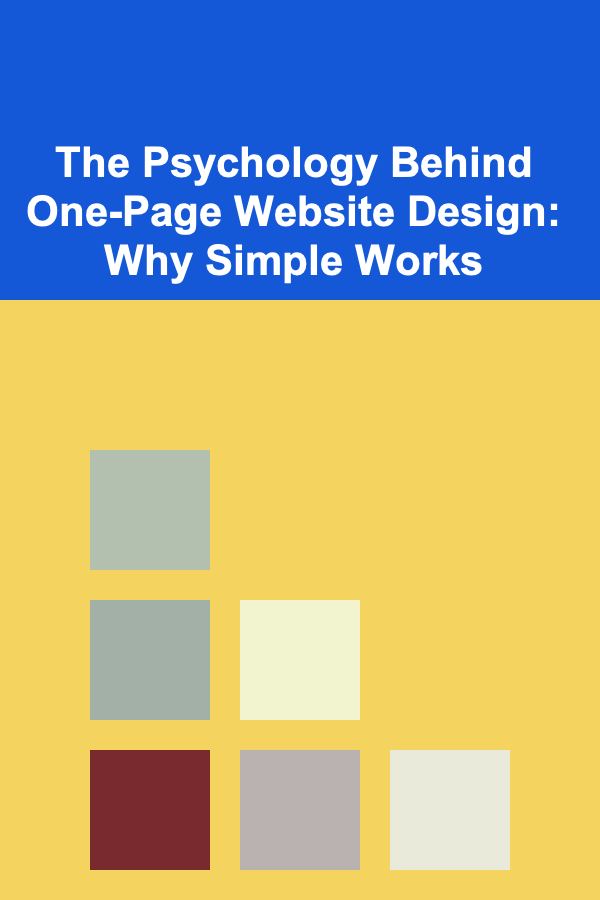
The Psychology Behind One-Page Website Design: Why Simple Works
ebook include PDF & Audio bundle (Micro Guide)
$12.99$9.99
Limited Time Offer! Order within the next:

In today's digital age, website design has become a fundamental part of a brand's identity and success. One of the most popular and effective trends in web design today is the one-page website. This minimalist approach, which condenses all content into a single page, has gained traction for its simplicity and ease of use. But why does this design approach work so well? To understand the power of one-page websites, we need to delve into the psychology behind the design. This article explores the cognitive and emotional factors that make one-page websites so effective, and why simplicity often works best.
The Rise of One-Page Websites
One-page websites have become a dominant trend in modern web design. In fact, many businesses, organizations, and even personal brands are opting for this type of website layout to communicate their message more effectively. The core reason for this shift is the increasing demand for user-centric design. People want to quickly access information without being overwhelmed by an abundance of choices. One-page websites provide a straightforward solution to this desire for simplicity.
The decision to design a website on a single page is not arbitrary. It reflects a deeper understanding of human behavior, web browsing patterns, and cognitive processes. While a multi-page website might have its place for larger, more complex businesses, one-page websites are particularly appealing to visitors looking for quick answers, clear navigation, and an easy browsing experience.
The Cognitive Science of Simplicity
Simplicity is at the heart of human cognition. The human brain tends to favor simplicity in processing information, as it minimizes cognitive load. Cognitive load refers to the mental effort required to understand and process information. When presented with too many choices or complex designs, the brain experiences an overload of information, which can result in confusion, frustration, or disengagement. This phenomenon is often referred to as the "paradox of choice."
In the context of web design, the simpler the layout, the less effort is required from the user to navigate the site and find the information they need. One-page websites capitalize on this principle by presenting content in a streamlined, linear fashion. Visitors can scroll through the page, taking in information in a seamless flow without the need to click through multiple pages. This reduces cognitive friction and enhances the overall user experience.
The Gestalt Principles and One-Page Design
The Gestalt principles of perception are fundamental to understanding how people process visual information. These principles suggest that people tend to perceive objects as part of a larger whole, rather than as individual elements. In one-page websites, this holistic view plays a key role in guiding users through the content.
For example, the principle of proximity states that items placed close together are perceived as belonging to the same group. In one-page design, this can be leveraged to create a visual flow that directs the user's attention from one section to the next. By strategically placing content and visual elements in close proximity, designers can lead users through the page in a natural, intuitive manner.
The principle of continuity is another important concept that applies to one-page websites. This principle suggests that the human eye is drawn to smooth, continuous lines. One-page websites often feature continuous scrolling, which appeals to this innate preference for fluid motion. The lack of page breaks allows users to effortlessly navigate the site, encouraging them to explore further without disruption.
Emotional Engagement: Building a Connection Through Design
Human psychology is heavily influenced by emotions. When users visit a website, they don't just process information cognitively; they also react emotionally to the design, content, and messaging. The design of a one-page website can evoke a range of emotions that play a crucial role in user engagement.
The Power of Visual Storytelling
One-page websites are uniquely suited to visual storytelling. Since all content is presented on a single page, designers can craft a cohesive narrative that unfolds as the user scrolls down. Visual elements such as images, videos, typography, and color are strategically used to communicate the brand's message in a way that resonates emotionally with the audience.
Storytelling is a powerful tool in branding because it helps create a sense of connection and relatability. By using visuals that align with the brand's values and voice, one-page websites can create a compelling narrative that engages users and encourages them to take action. This could be anything from making a purchase to signing up for a newsletter or even sharing the website with others.
The Emotional Impact of Minimalism
One-page websites often embrace minimalism, a design philosophy that emphasizes simplicity and the removal of unnecessary elements. Minimalism has been shown to have a positive emotional impact on users. It creates a sense of clarity and focus, making it easier for users to process the information presented.
By eliminating clutter and distractions, a minimalist one-page design helps users feel more in control of their experience. This emotional state of calm and control can increase the likelihood of conversion, whether that conversion is a sale, a lead, or simply a positive interaction with the brand.
Moreover, minimalism is associated with sophistication and modernity. Brands that adopt this design philosophy are often perceived as innovative, professional, and forward-thinking. This perception can significantly enhance the credibility of the brand and strengthen the emotional bond with the user.
The Psychology of Scrolling: A Natural Action
One of the most important psychological aspects of one-page websites is the act of scrolling. Scrolling has become second nature to most internet users, especially with the rise of mobile browsing. Research has shown that users prefer scrolling to clicking, as it is more intuitive and less disruptive to the browsing experience.
When users scroll through a one-page website, they feel a sense of control over their journey. This act of scrolling creates a continuous, uninterrupted flow of information, allowing users to engage with the content in a relaxed manner. This differs from clicking through multiple pages, which can feel more fragmented and disjointed.
The Endowment Effect and Commitment
The endowment effect is a psychological phenomenon in which people assign more value to things they own or are familiar with. One-page websites can tap into this effect by creating a sense of ownership and commitment as users scroll through the content. The more users engage with the page, the more they become emotionally invested in the brand.
By the time a user reaches the end of a one-page website, they may feel a sense of attachment to the brand, which can increase the likelihood of conversion. This commitment, driven by the gradual engagement with the content, is more powerful than the passive consumption of information on a multi-page website.
Conversion Psychology: Why Simplicity Drives Results
At the end of the day, most websites are designed with one goal in mind: to convert visitors into customers, leads, or followers. One-page websites are particularly effective at driving conversions because they focus on guiding the user towards a single action. By streamlining the user journey, one-page websites eliminate distractions and make it easier for users to complete their desired action.
Reducing Choice Paralysis
One of the key psychological factors that hinder conversions on websites is choice paralysis. When users are presented with too many options, they often feel overwhelmed and struggle to make a decision. This can result in users abandoning the website without taking any action. One-page websites help mitigate choice paralysis by presenting a clear, linear path for users to follow.
On a one-page website, there is usually one primary call to action (CTA), whether it's purchasing a product, signing up for a newsletter, or requesting more information. By focusing the user's attention on this single action, the design reduces the cognitive load and guides the user towards a decision.
The Reciprocity Principle
The reciprocity principle is a powerful psychological trigger that can drive conversions. This principle suggests that people feel a natural urge to return favors. One-page websites often leverage this by offering something of value upfront, such as a free download, an exclusive offer, or valuable content.
By providing users with something useful or desirable, one-page websites activate the reciprocity principle. Users may feel compelled to return the favor by completing the desired action, whether that's making a purchase or signing up for a service. This creates a sense of mutual benefit, which enhances the likelihood of conversion.
The Role of User Behavior in One-Page Website Design
Understanding user behavior is crucial to designing an effective one-page website. People browse the web in a predictable way, and one-page websites are specifically designed to align with these browsing patterns.
The F-Pattern of Web Browsing
Studies on web browsing behavior have shown that users tend to scan websites in an "F" pattern. This means that they focus on the top left corner of the page, scanning horizontally across the top, then vertically down the left side, before moving across the page again. This pattern is important to consider when designing a one-page website, as it influences where key elements, such as calls to action and important content, should be placed.
One-page websites can use this pattern to their advantage by placing key elements along the top or left side of the page, ensuring that they are the first things users see as they begin to scan. By doing so, designers can capture the user's attention quickly and guide them toward conversion.
The Importance of Mobile Optimization
As mobile usage continues to increase, mobile optimization has become a crucial factor in web design. One-page websites are inherently well-suited for mobile devices, as they eliminate the need for complicated navigation and long page loads. The seamless scrolling experience on a one-page site is intuitive and easy to navigate on smaller screens, which makes it an ideal choice for mobile users.
Moreover, mobile users are often in search of quick answers and streamlined experiences. One-page websites cater to this need by presenting all essential information on a single screen, making it easy for users to access what they need without unnecessary clicks.
Conclusion: Why Simple Works
The psychology behind one-page website design reveals the powerful impact of simplicity on user engagement, emotional connection, and conversion. By leveraging cognitive principles, such as the reduction of cognitive load and the creation of a seamless browsing experience, one-page websites provide users with a focused and intuitive path to information. The emotional impact of a minimalist design further enhances the user experience, fostering a sense of trust, sophistication, and calm.
Ultimately, simplicity works because it aligns with how humans process information, make decisions, and engage emotionally with content. One-page websites tap into these psychological principles, creating an effective and efficient user experience that drives results. As web design continues to evolve, the power of simplicity will remain a key factor in creating websites that resonate with users and deliver real business outcomes.
Other Products

Elevating Brand Visibility: Tactics and Strategies for Advertising Managers
Read More
How to Build a Fundraising Campaign Communication Checklist
Read More
How to Incorporate Decorative Elements for Garden Aesthetics
Read More
How to Make DIY Board Games for Family Fun
Read More
How to Partner with Influencers to Promote Your T-Shirts: An Actionable Guide
Read More